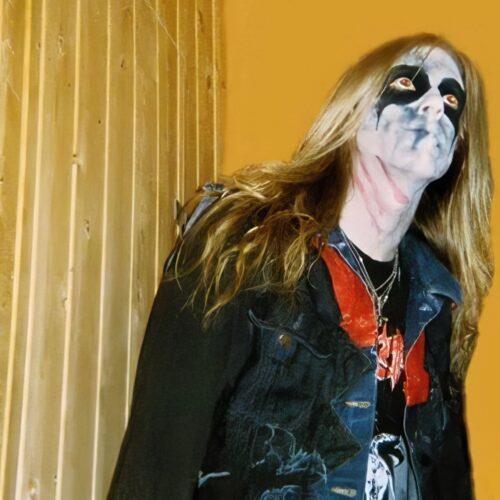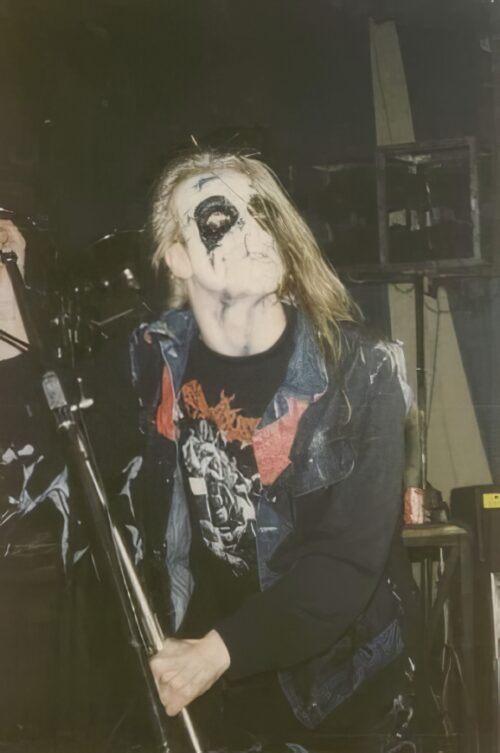There’s a pretty common belief in the scene that two main reasons led to Per “Dead” Ohlin’s suicide: first, that he’d become deeply disillusioned after death/black metal got “corrupted” by mainstream success, and second, that after a near-death experience as a kid, he developed a morbid fascination with death that never left him.
Dr. Schitz, a close friend of Dead and his bandmate in MORBID, doesn’t buy into that at all. In fact, he says those claims are basically a myth — partly started by Euronymous, and later spread by outsiders who never actually knew Dead personally or had any real access to the “inner circle” of Morbid/Mayhem to know things first-hand.
 “Is there an interview with Pelle where he says that ‘Dead’ came from his near-death experience? I highly doubt that.” says Dr. Schitz and points back to Dead’s traumatic childhood:
“Is there an interview with Pelle where he says that ‘Dead’ came from his near-death experience? I highly doubt that.” says Dr. Schitz and points back to Dead’s traumatic childhood:
“The young Ohlin was subjected to brutal bullying in school, and when he was 10 years old he was beaten so badly that his spleen ruptured. He went home to try to get some rest and was later found unconscious by his stepmother, who was a nurse. His pulse was weak but I doubt it ever stopped completely; he was rushed to the emergency ward and operated on. I don’t think he was ever pronounced dead though.”
“The thing is, he never spoke about it. He even lied to his friends about the scar, claiming it was from eating poisonous mushrooms and having to get surgery, but that was the only thing he ever lied about. In my opinion, he couldn’t bring himself to talk about what had really happened.”
Trauma victims will often desperately try to avoid the source of the distress – and in doing so, some will instead end up becoming fixated with it.
“And so,” Dr. Schitz continues, “Pelle became obsessed with death. This obviously contributed to the choice he ultimately made but it’s not WHY he did it.”
In early 1988 Dead left Sweden for Norway to join MAYHEM. Before leaving friends, MORBID, and family behind in Stockholm at 19 years of age, Ohlin was already renowned for his total dedication to the fundamental concepts of black and death metal. Once he partnered up with Øystein ‘Euronymous’ Aarseth, MAYHEM’s guitar player, his passion had reached obsessive lengths. 
“Dead was incredibly anti-everything that was commercial. He wanted to be as underground as he could possibly be”, Dr. Schitz remembers.
Over the three years he was part of MAYHEM, they played only four gigs outside Norway – three in Germany and one in Turkey. MAYHEM was going nowhere. Simultaneously, many of the Swedish bands that Pelle had pissed on in interviews were drinking beer in nightliners, being driven to shows all across Europe. He had missed that train, and it was really starting to eat away at him.
Pelle had begun starving himself and was displaying self-harm tendencies. He stopped taking care of himself and was no longer even washing at this point. I think we can establish without any reasonable doubt that he was deeply depressed.
“The night Dead killed himself he was alone in that shitty “Mayhem house”, it was Easter and all of his friends were either with girlfriends or family. Much of the driving force behind his suicide was a lot more tragic than what’s been projected by outsiders and ascribed to him by Øystein. From our conversations and correspondence I got the impression that Øystein treated him like shit, he bullied him – something Pelle did not handle well. I think taking those fucking photos says more than words can ever convey in this regard.”
Dr. Schitz says that in most cases of depression-related suicide, it doesn’t happen when the afflicted is at the absolute lowest. It usually follows a brief alleviation of the pain, in the wake of a glimpse of light.
“In this case, it was his decision to move back home to Sweden. Pelle had applied for art school and we had started rehearsing with MORBID again, his mother later told me he was incredibly excited to be back playing with Gehenna (guitars) and me.”
If that was the case, then why didn’t he follow through?
“While there was a chance of real change just around the corner, I don’t think it felt all that appealing to him. Especially coming back home empty-handed after all this time, when many of his former friends had become successful musicians. When we rehearsed, I imagine he must have realised that things were never going to go back to the way they once were – we had grown up, and had jobs. No one that knew Pelle would claim a fascination for death was decisive in his choice, he was simply deeply depressed.” 
Pelle ‘Dead‘ Ohlin ended his own life on April 8, 1991; his body was found by Aarseth, who took the now infamous pictures. Dr. Schitz dismisses the claims by the latter that Ohlin’s demise was in any way influenced by the state of the scene as laughable.
“This notion of the suicide having anything to do with corruption of black metal is incredibly naïve. Pelle was miserable and despite planning new beginnings back in Sweden, he simply couldn’t see a way out of it.”
Note:
This article is based on an interview that was published in the magazine “Bardo Methodology” #1.